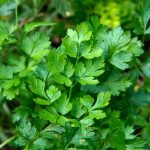 The ancient Greeks called parsley selinon, a word that became—via Latin, Italian, and then French—the English word celery. This Greek name for the parsley plant may have shifted to the celery plant because—in dim light, from a great distance—the two plants are not dissimilar; scientists, at least, have seen fit to place both celery and parsley in the Umbelliferae family of plants, a family distinguished by the parasol shape of its species’ flowers. The word parsley, on the other hand, developed from the Greek name for a specific variety of parsley called petroselinon, literally meaning rock parsley. The Greek petros, incidentally, is also the source of Peter, a name whose stony associations have led to its being used in the word saltpetre and also as a nickname for the male erection. Parsley appeared in English almost a thousand years ago, but celery did not appear until the mid seventeenth century shortly after it began to be cultivated for culinary purposes. Prior to this, the same plant, known since the thirteenth century as smallage, was harvested from the wild. This earlier name, smallage, literally means small parsley, the age part of the word having developed from the Greek apion, another word for parsley.
The ancient Greeks called parsley selinon, a word that became—via Latin, Italian, and then French—the English word celery. This Greek name for the parsley plant may have shifted to the celery plant because—in dim light, from a great distance—the two plants are not dissimilar; scientists, at least, have seen fit to place both celery and parsley in the Umbelliferae family of plants, a family distinguished by the parasol shape of its species’ flowers. The word parsley, on the other hand, developed from the Greek name for a specific variety of parsley called petroselinon, literally meaning rock parsley. The Greek petros, incidentally, is also the source of Peter, a name whose stony associations have led to its being used in the word saltpetre and also as a nickname for the male erection. Parsley appeared in English almost a thousand years ago, but celery did not appear until the mid seventeenth century shortly after it began to be cultivated for culinary purposes. Prior to this, the same plant, known since the thirteenth century as smallage, was harvested from the wild. This earlier name, smallage, literally means small parsley, the age part of the word having developed from the Greek apion, another word for parsley.
A sweet, annual herb of the carrot family that has tender, bushy leaf clusters.
A type of herb featuring finely cut, dark-green leaves that are employed both as a decorative element and a flavoring agent in a diverse array of dishes, including eggs, fish, meats, and all types of vegetables. It is also frequently included as an ingredient in the bouquet garni, a classic element in French culinary practices. With around thirty distinct cultivars, this herb belongs to the carrot family and comes in a range of curly and colored varieties, such as the double-curled, moss-leaved, fern-leaved, and turnip-rooted types.
An indispensable herb, characterized by its vibrant, curled bright green leaves, serves a dual purpose as both a flavorful ingredient and an eye-catching garnish. This herb encompasses three primary varieties: domestic, extra curly dwarf, and Italian. The domestic and curly variations find widespread use as garnishes, adding visual appeal to culinary creations. The Italian variety distinguishes itself with its flat leaves and slightly bolder flavor, often finding its way into soups to enhance their taste profiles. There exists a variant with turnip-like roots, primarily cultivated for its sizable underground parts. While the foliage of this type can be chopped and utilized for flavoring purposes, it falls short in comparison to other varieties in terms of taste. It is worth noting that what is commonly referred to as Chinese parsley is, in fact, the foliage of cilantro or coriander leaves.
